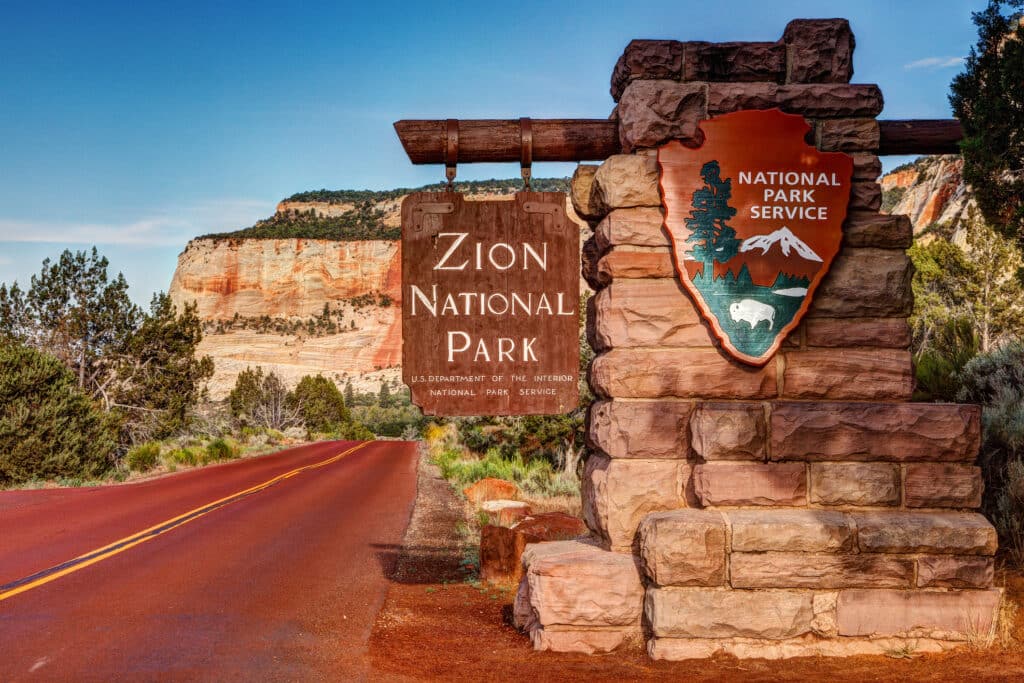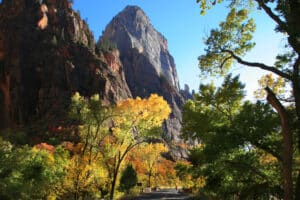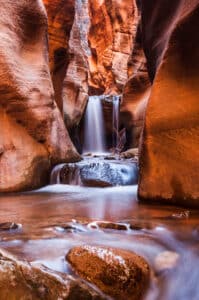
Zion National Park currently charges a one-week entrance fee of $35 per vehicle, covering all passengers in a private car. If arriving on a motorcycle, the fee is $30 for the bike and rider (also valid for 7 days). Visitors entering on foot or bicycle pay $20 per person (ages 16 and up), and youth 15 and under enter free.
The park also offers an annual Zion Pass for $70, which is valid for a year at Zion only, and of course the interagency America the Beautiful Pass ($80) is accepted and covers Zion along with all other national parks. Senior citizens (62+) can obtain discounted lifetime or annual passes (e.g. a lifetime Senior Pass for $80), and U.S. military members and veterans are eligible for free annual passes. Even families with a 4th grader can get a free national parks pass, which we saw many taking advantage of at Zion’s gate. The park itself never requires any special booking or timed-entry reservations – just pay the fee and you’re in.
Zion is open 24 hours a day, 7 days a week, year-round, though specific facilities and services maintain seasonal hours. In summer peak season, the Zion Canyon Visitor Center is typically open from 8 a.m. to 7 p.m. (with slightly shorter hours in winter), and a free shuttle bus runs daily up the main canyon from early morning until evening. When the shuttles are operating (generally spring through fall), private vehicles are not allowed on the Zion Canyon Scenic Drive beyond the visitor center, so plan on using the efficient shuttle system during those months. In the quieter winter season, the shuttles pause and visitors are allowed to drive their own cars up the canyon; facilities like the museum or ranger desks also operate on shorter schedules in winter. Seasonal factors can affect access: during summer’s high wildfire danger, campfires are often banned in the campgrounds, and after heavy rains or snow some trails or roads may close temporarily (for example, The Narrows can close after flash floods, and high-elevation roads may get snow). Always be prepared for minor restrictions aimed at safety and conservation. We visited on 18 August 2025, and all figures were valid then.
About the Zion National Park
Established in 1919 as Utah’s first national park, Zion protects a magnificent desert canyon ecosystem and a rich tapestry of natural history. (Originally the area was proclaimed as Mukuntuweap National Monument in 1909, before being expanded and renamed Zion a decade later.)
The name “Zion” was given by early Mormon settlers, meaning a refuge or sanctuary, and it’s easy to see why they felt that way. Ever wondered how Zion’s towering cliffs formed in the first place? Over millions of years, the North Fork of the Virgin River has carved down into layers of brilliantly colored Navajo Sandstone, creating sheer walls that rise up to 2,000 feet. These rock layers record 150 million years of earth’s history, from ancient deserts to sea beds. The result is a deep canyon accented by monoliths, buttes, natural arches and narrow slot canyons – a geologic wonderland that draws hikers, geologists, and sightseers alike.

Beautiful Landscape in Zion National Park,Utah,United States
The park spans 229 square miles of the Colorado Plateau region, with elevation ranging from about 3,700 feet at the canyon floor to over 8,700 feet on high plateaus. This great elevation variance means Zion contains multiple life zones and habitats. Arid desert scrub thrives in the lowlands, while riparian woodlands of cottonwood and willow line the river, ponderosa pine forests and even aspen groves cling to the higher mesas. The biodiversity here is impressive – there’s also dozens of unique plant species adapted to microclimates like hanging gardens on dripping sandstone walls. Wildlife is equally varied: mule deer are commonly seen browsing in the mornings, rock squirrels dart between the bushes, and sometimes desert bighorn sheep can be spotted picking their way along cliff ledges. Over 280 species of birds have been recorded, from hummingbirds to condors. In fact, Zion is part of a notable conservation success story: endangered California condors have been reintroduced to the region and occasionally soar above the canyon (we glimpsed one high above Kolob Terrace – a thrilling sight). Other sensitive species like the Mexican spotted owl and native fish in the Virgin River are carefully protected by park biologists.

Zion National Park, Utah, USA
The park’s management even designated about 90% of Zion as wilderness to ensure these natural communities stay wild. They actively manage wildfires too; lightning-sparked fires are sometimes allowed to burn under watch in remote areas to benefit the ecosystem, and occasional prescribed burns are conducted to reduce invasive grasses after events like the large Kolob wildfire in 2006 (which burned over 10,000 acres in Zion).
From a visitor’s perspective, Zion offers an abundance of outdoor activities, with hiking being the star attraction. Popular trails range from easy family walks to bucket-list challenges. The iconic Angel’s Landing trail is perhaps Zion’s most famous hike – a steep 5-mile round trip that culminates in a narrow ridge climb with chains and jaw-dropping views of the valley. (Due to its popularity and sketchy narrow sections, a permit system now limits the number of hikers on Angel’s Landing each day.) Down in the canyon bottom, the Narrows provides a completely different adventure: it’s not so much a trail as a trek through the Virgin River itself, wading between the towering slot canyon walls.

Kanarra creek slot canyon in Zion national park, Utah.
We loved walking in the cool river water on a hot afternoon, hemmed in by 1,000-foot-high sandstone on both sides – truly unique! For something more relaxed, Emerald Pools Trail leads to waterfalls and emerald-colored pools in an oasis-like side canyon, and it’s suitable for most ages. There are also short strolls like the Riverside Walk (a paved path along the river to the Narrows entrance) and the Pa’rus Trail, which is a flat path open to bicycles that follows the valley floor with lovely views. In the higher elevations, hikers can explore trails such as Observation Point (which overlooks the entire Zion Canyon from above) or venture into the less crowded Kolob Canyons area for hikes like the Taylor Creek trail to a double arch alcove.

The Observation Point Zion national park
With so many options, you might ask: Is one day enough to experience Zion? In our experience, one day lets you sample the highlights, but we recommend staying at least two full days if you can. Most visitors spend 2 to 3 days here, which allows time to hike a couple of the big trails and also enjoy the scenery without rushing. We’ve spent days here and still haven’t done everything – we were gonna attempt the famous Subway slot canyon on this trip (a challenging permit-only route through a tunnel-like canyon), but we had to save it for next time. It’s that kind of park: endlessly fascinating, with layers of natural and cultural stories, from the Paiute people who considered this canyon home to the early pioneers and artists who helped make Zion known to the world. Through a factual lens or an adventurous one, Zion National Park lives up to its reputation as a crown jewel of America’s parks, blending accessible beauty with genuine wilderness.
Nearby Sights
While Zion Canyon is the main draw, we discovered plenty of other sights and activities in and around the park that enriched our visit. One afternoon, we drove out to the Kolob Canyons section (a quieter northwest enclave of the park accessible off I-15). There we enjoyed a scenic 5-mile drive up to Kolob Canyons Viewpoint, where a short walk led to a stunning overlook of multi-hued cliffs cutting into the plateau. It was peaceful up there – hardly any other people, just red rock walls and juniper trees, a nice change from the busier main canyon.
We also ventured along the Zion-Mt. Carmel Highway toward the park’s east entrance. This road climbs out of the main canyon via a historic tunnel and reveals a different side of Zion: rolling slickrock domes and sculpted rock formations like Checkerboard Mesa (named for its grid-like erosion patterns). We pulled over at a few small turnouts to take in the views. In this area we even spotted footprints of bighorn sheep on the sandstone (their actual owners were elusive in the midday heat). For those interested in longer excursions, we’d highly recommend driving the backroad up to Lava Point on Kolob Terrace. We did this on our second morning – the road took us through high meadows and Ponderosa pines to a lofty overlook at Lava Point, which offers one of the highest panoramic views of the park. It was kinda amazing to feel the temperature drop up there and to look out over Zion’s vast backcountry that most visitors never see.
There are also opportunities for biking: we saw folks cycling the Zion Canyon Scenic Drive early in the morning (you can bike that route when shuttles are running, and the shuttle buses will even rack your bike if you get tired). Water activities are a bit limited since the Virgin River is quite shallow and rocky – it’s not really suited for kayaking – but on a hot day some visitors (including us) waded in at the river’s edge to cool off. Outside the park boundaries, more adventures await: east of Zion, in the surrounding region, you’ll find places like Coral Pink Sand Dunes State Park (with ATV rentals on bright orange dunes) or Bryce Canyon National Park about 1.5 hours away, if you’re extending your road trip. But even immediately around Zion, there was plenty to do once we stepped outside the gates each day.
Wondering where to relax and recharge after all that hiking? Luckily, the tiny gateway town of Springdale sits right at Zion’s south entrance and it’s packed with dining and rest options that cater to dusty, hungry park-goers like us. We made it a point to sample the local eateries every evening. One night, we had a fantastic dinner at Oscar’s Cafe, a beloved Springdale staple known for its hearty portions. Their southwestern burgers and fish tacos were just what our appetites needed after a long trail day (we can vouch that the “Murder Burger” really hit the spot, piled high with toppings).
On another occasion we stopped by the Zion Canyon Brew Pub, which is conveniently located next to the park entrance. Sipping a cold pint of their house-brewed Springdale Amber ale on the patio, we enjoyed a view of the towering canyon walls glowing in the sunset. The pub’s menu of homemade nachos and fish & chips was satisfying – we’d definitely recommend it if you’re craving a casual bite and a local beer. Mornings in Springdale were lovely too: we grabbed breakfast burritos and coffee at a small café (the town has a few, all with friendly service). After coming out of the park in the afternoons, we often treated ourselves to ice cream from a local shop to beat the Zion heat. Beyond food, Springdale offered a chance to browse unique shops and galleries. We wandered through a local art gallery featuring stunning landscape photography and paintings by Utah artists – a relaxing post-hike activity that gave us a deeper appreciation for the scenery we’d just experienced firsthand. There are also gear outfitters on the main street where we rented a pair of neoprene socks and water shoes before tackling the Narrows hike (a tip we’re glad we followed). If you need any last-minute supplies or simply a break, this town has you covered despite its small size.
For those staying overnight, options range from campsites to comfy lodges. We camped at Watchman Campground inside the park for one night, where we fell asleep to the soft sound of the river and woke with the first light on the cliffs – a great experience (just reserve early, as sites fill up fast). Other nights we opted for a cozy motel in Springdale, enjoying a hot shower and real bed after our muddy Narrows trek.
Throughout our stay, we tried to mix early starts with midday rests to avoid both the crowds and the hottest hours. We recommend hitting the most popular trails at dawn if possible – for example, we caught the first shuttle at 6 a.m. and had the Emerald Pools practically to ourselves for a while, plus we saw deer grazing in the misty morning meadows. Conversely, by late afternoon and evening, Zion quiets down again, and that’s a perfect time to find a serene overlook or take a leisurely walk near the river as day visitors depart. In peak summer, the park can feel a bit busy midday, but by using these strategies we never felt too crowded. We’d also advise visiting in the shoulder seasons if you can (late spring or early fall) when the weather is milder and the crowds slightly thinner, yet everything is accessible. Our own trip in mid-August required dealing with heat around 100°F (38°C) and high foot traffic at times, but we managed just fine by staying hydrated and being strategic.
When all was done, we kicked back on our final evening at a little bakery café with iced coffee and watched the sunset paint the cliffs orange and pink. It was a simple moment but somehow captured the essence of Zion for us – grand scenery, a friendly community vibe, and a feeling of earned contentment after days of exploration. We drove away from Zion with dusty boots, a camera full of red-rock vistas, and a deeper appreciation for how special this place truly is.
Sorry, there were no items that matched your criteria.

